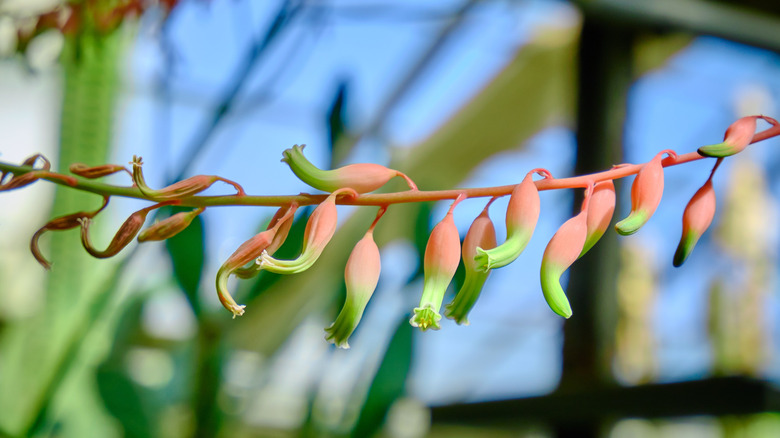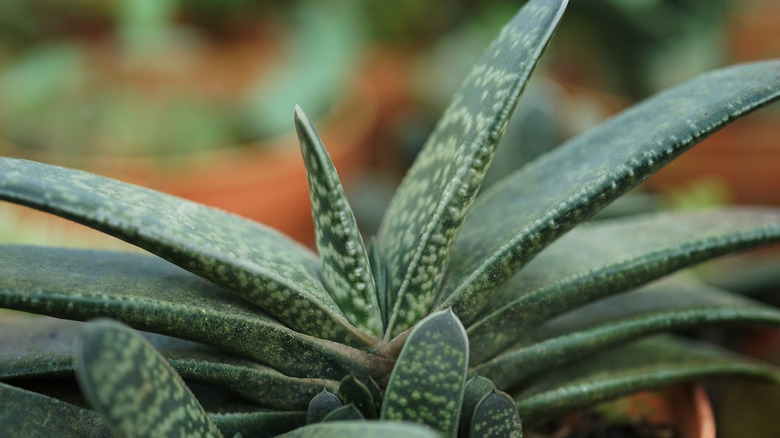Grow This Easy Flowering Plant Indoors For Colorful Blooms From Winter To Spring
We may receive a commission on purchases made from links.
From bone-chilling temperatures to early sunsets, winter can take its toll on us all. If you're someone who experiences seasonal blues, you can bolster your mood with houseplants. Incorporating nature into your living space is, arguably, the only home design style that is actually proven to make you happier. The dreary days of winter brighten when you cultivate an oasis of green indoors. If you're a fan of plants, there are quite a few houseplants that grow beautifully indoors during winter and spring. One low-maintenance option is a flowering succulent called gasteria (Gasteria spp.).
Also known as ox tongue, cow tongue, or lawyer's tongue, this compact, slow-growing succulent is native to South Africa. It features dark green or gray fleshy leaves with white speckles. The mother plant produces shoots frequently, forming an attractive cluster of foliage quickly if given the space. Ox tongue flowers grow on a long stem from the center of this rosette. The tubular blooms, which resemble bells, hang single-file from the stem. They could be bright pink, orange, or red, always with a light green tip. They last from winter through to spring.
How to help your ox tongue bloom this winter
As mentioned above, ox tongue succulents often bloom in the winter, but they can, in fact, flower in any season. In general, this succulent tends to grow the most when it is cooler, which is encouraging for cold-season flowering. However, blooming is not a given. A young or stressed ox tongue may not flower. A few minor tweaks in your care routine can make or break when it comes to ensuring you'll see those vibrant bell-like blooms. Luckily, ox tongue maintenance is easy.
In general, ox tongues will still produce their beautiful blooms in partial shade. They need a window of two to six hours of bright sunlight a day. Don't let the temperature drop below 50 degrees Fahrenheit in whatever room you keep your plant. Just like most other succulents, ox tongues don't need much water at all. Allow the soil in the planter to dry out completely before you next add water. Monitor your succulent throughout the winter and address any issues you notice, such as root rot, pests, or disease, promptly. For example, brown spots on the leaves are a dead giveaway for fungal disease. As long as you're giving your ox tongue the right amount of sunlight, water, and care it needs, it should bloom prolifically.
Tips for keeping your ox tongue thriving year-round
Ox tongues are highly susceptible to pests and fungal and other diseases all year round, so regularly inspect your plant for signs of illness in all seasons. It's also vital to keep your ox tongue in a pot with drainage holes filled with fast-draining, mineral-rich soil. While these houseplants are less sensitive to overwatering than other succulents, it's still best practice to continue your winter-to-spring routine of only watering your plant when the soil is completely dry. Unusually, they can be more sensitive to abundant waterings during the hottest months of the year, when their growth slows.
You can take your ox tongue outside in the summer, as long as you don't put it anywhere with bright, direct sun. Unlike most succulents, which love the sun, this plant loves partial shade outdoors as much as it does indoors. However, it remains a houseplant that thrives in dry climates, so be cautious about taking it outside if you live in an area with rainy, humid summers. Apply fertilizer sparingly — a dose of Miracle-Gro Succulent Plant Food just once in the spring is enough. If you keep all of this in mind, your ox tongue will thrive, and you'll get to enjoy its pretty winter blooms year after year.


